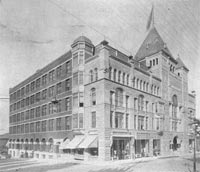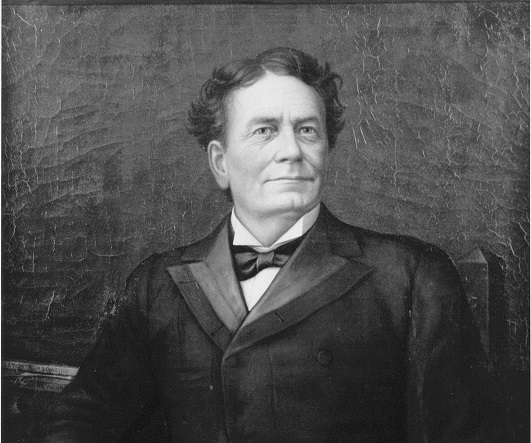The Warder Grand Theater prepared for its glorious debut which would occur on October 26, 1887. The product of George Woodward Warder’s ambition and financing, it was the third theater in Kansas City after the Coates Opera House and Gilliss Theater. Warder intended it to outshine the other two theaters in both size and luxury.
Scheduled to star in the production of Othello was Edwin Booth, member of the most famous American acting family of the nineteenth century and brother of John Wilkes Booth, President Abraham Lincoln’s assassin. Construction had fallen behind schedule, though, and the new theater still lacked a heating system, seats, dressing rooms, complete stage flooring, and most notably, a roof.
An unusually cold October greeted Booth upon his arrival in Kansas City, so the performance was postponed two days from the original date to allow workers to remove snow from the stage, install temporary seating, place portable heating devices behind the stage, and put a tarp over the roof area. On October 26, Othello finally premiered in front of a chilled capacity crowd, many of whom paid the then-astronomical sum of $50 per ticket. Despite the distractions, Booth reportedly gave a rousing performance.
Edwin Booth starring in the premiere was more than just a strategy to sell tickets. According to theater historian Felicia Londré, George Warder, a lawyer and real estate investor who moved to Kansas City in 1878, wanted to build the theater in part to reflect his Southern sympathies.
Most Northern migrants to Kansas City had settled in the western part of the city, while most Southern migrants to the city had settled in the eastern portion. The Coates Opera House on Quality Hill at the west side of the city had been financed by philanthropists originally from New England, several of whom had fought for the North in the Civil War. The Gilliss Theater, located downtown, catered to lower-class clientele. Warder wanted to give the Southerners on the east side their own cultural hub, and choosing the brother of John Wilkes Booth for the premiere made his declaration clear.
Warder’s eccentric political statement aside, most remembered the theater for the performers it attracted and the luxury it possessed. While Warder overestimated the political divisions among Kansas City residents, he underestimated the cost of the theater. Instead of $150,000, the theatre cost $350,000 to complete, causing his bankruptcy in 1890. The theater, later renamed the Auditorium Theater and rebuilt under new ownership after a fire in 1897, continued to attract leading performers to Kansas City until its demolition in 1960.
View images of George Warder and the Warder Grand / Auditorium Theater from the Missouri Valley Special Collections.
- Auditorium Theater, late 1880s
- Auditorium Theater, 1905
- Auditorium Theater, postcard
- George Woodward Warder
- Coates Opera House Theater
Check out the following books about theaters in Kansas City.
- The Enchanted Years of the Stage: Kansas City at the Crossroads of American Theater, 1870-1930, by Felicia Hardison Londré; provides an excellent history of early theaters in Kansas City, including a detailed biography of George Warder, pp. 153-162.
- Kansas City Style: A Social and Cultural History of Kansas City as Seen through its Lost Architecture, by Dory DeAngelo & Jane Fifield Flynn; contains short synopses and photographs of the Coates Opera House and Warder Grand / Auditorium Theater, pp. 52-53, 194-195.
- A History of the Standard Theatre, Kansas City, Missouri, 1900- 1929, by Michael G. Luce.
Continue researching George W. Warder using Vertical File: Warder, George W. from the Missouri Valley Special Collections.
References:
Dory DeAngelo, What About Kansas City!: A Historical Handbook (Kansas City, MO: Two Lane Press, 1995), 115.
Dory DeAngelo & Jane Fifield Flynn, Kansas City Style: A Social and Cultural History of Kansas City as Seen through its Lost Architecture (Kansas City, MO: Harrow Books, 1990), 194-195.
Felicia Hardison Londré, The Enchanted Years of the Stage: Kansas City at the Crossroads of American Theater, 1870-1930 (Columbia: University of Missouri Press, 2007), 140-141, 153-162.



